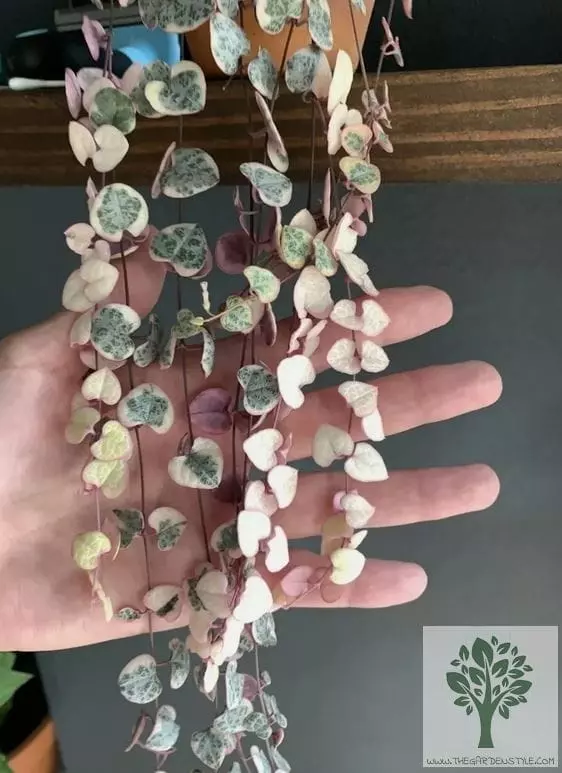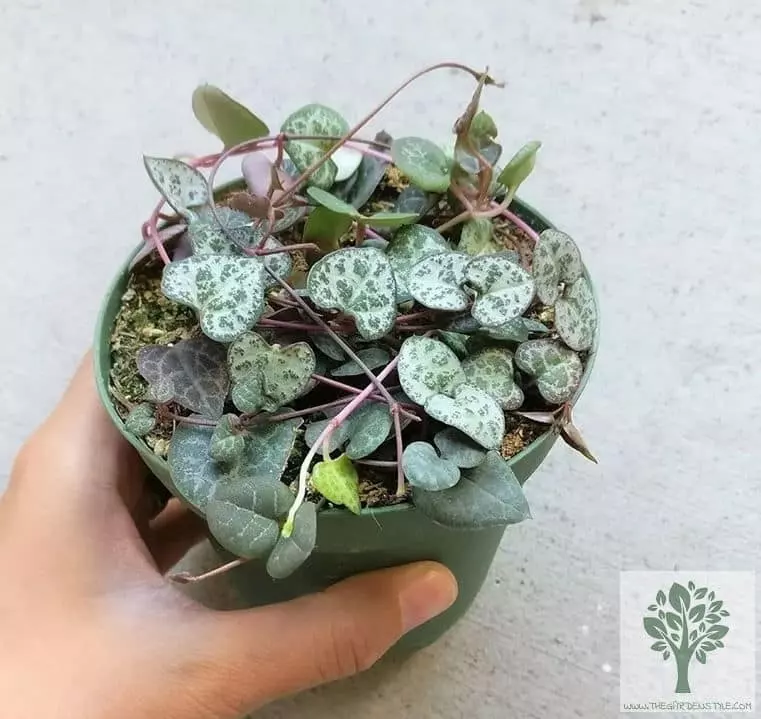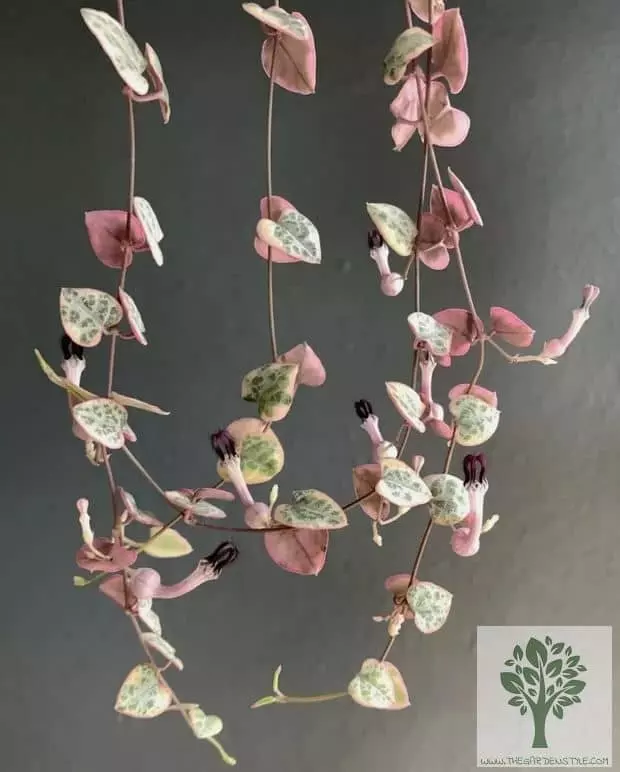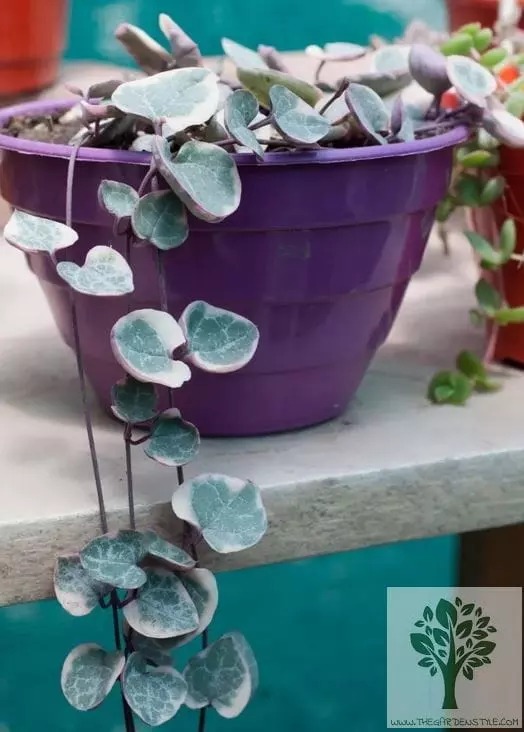In nature we can see that plants have many textures, colors, and shapes, some of them as curious as to the protagonist of this article, we refer to the String of Hearts (Ceropegia woodii).
And like all succulents with curious shapes, this plant is commonly known by several names that I list below:
- Hearts-on-a-string.
- Rosary vine.
- Collar of hearts.
- Chain of hearts.
It has earned all these nicknames because its leaves are heart-shaped and, because of the long stems from which they grow, it looks like a necklace or chain.
Sting of Hearts is a hanging succulent that will give a very special touch to your collection, especially if you want your balcony or the front of your home to be full of life and beauty with this plant.
It is also a climbing plant, so if you have a project with a wall or a fence and you want to fill it with hearts, this succulent is perfect for you.
Table of Contents
Characteristics of String of Hearts
This magnificent succulent is native to southern Africa and belongs to the Apocynaceae family.
Its stems are very long, thin, reddish, and reach up to 13 ft (4 meters), the length it reaches will depend on the taste of the owner of the plant because you can let it continue to grow or prune it.
A very curious characteristic of this succulent is that its roots are tuberous, they have a kind of tubercle or balls and that is where its water reserves are located.
Its leaves are fleshy and heart-shaped and are not green, but have a gray pattern as if they were forming the veins of each heart-shaped leaf.
Isn’t it a beautiful succulent? Well now without wasting any more time let’s learn how to take care of String of Hearts.
- All of our listings have very representative pictures of what you would receive.
- This plant comes fully rooted in a 6" pot, ready to grow in and your beautiful home or your office.
- California Tropicals

Care of String of Hearts
Light:
String of Hearts does not need direct sun exposure, but what we are going to provide is a place where it receives very good lighting, with this we will get its leaves to acquire a bright green color.
If it does not receive sufficient illumination the color of its leaves will be a little more opaque.
If you want to provide it with some direct sunlight you can do it, but only for a few hours and preferably in the mornings, when the sun’s rays are not so intense.
By doing this you will also notice that its stems will grow many more hearts.
Water:
String of Hearts is a succulent that has a slightly different water requirement than most succulents in that it favors having a little more moisture in its substrate.
So we are going to provide a substrate that retains a little moisture, we will notice if our String of Hearts needs water because its leaves, instead of being plump, will be very flat, this will indicate that we have to give it a little more watering.
The frequency of watering will be the same as for most succulents: every time the substrate is dry, about once a week will be enough.
In autumn and winter, we will reduce the watering of our String of Hearts to only once a month, since in that period it will be inactive or in a resting state.
Temperature:
Our String of Hearts is a succulent that will develop best in places with a temperature that is between 59°F to 79°F (15°C to 26°C).
It likes warm, well-lit climates, but be careful not to expose it to temperatures below 46°F (8°C), as it does not tolerate them.
If the winter temperatures in your area are very low, we recommend keeping your Ceropegia woodii indoors, preferably near a window so that it receives plenty of light.
Substrate:
For our String of Hearts to stay healthy and grow we are going to provide it with a substrate that drains well, that does not puddle but retains a little moisture, that is, that does not dry out so quickly.
For this, we recommend that in the mixture you use you add a little perlite, which are minerals that will help us in this purpose.
A mixture that should help you is to use:
60% Perlite (Order it here).
40% Black soil (Order it here).
This is a basic mixture, but remember that you should adapt it according to the conditions of the place where you live and the materials you have at your disposal. You should also use a commercial succulent substrate like the one we use (Order it here). Learn more about How to Repot Succulents.
Fertilization:
String of Hearts like most succulents does not need fertilization, but if you want to provide it with a little extra nutrient, we recommend you to do it during its active period which is between spring and summer, and that it is a fertilizer rich in potassium (Order it here).
Learn more about Fertilizer for Succulents.
How to Propagate String of Hearts
To avoid complications, I recommend that you propagate your String of Hearts through cuttings.
We should propagate our Ceropegia woodii by cutting one of its twigs and planting it so that it develops roots.
We should also take a twig from one of the tubers where it starts, plant it and let it develop, and give us a new and leafy plant.
If what you want is to have a very full pot, you should take some stems from your String of Hearts and without displacing them twine them in a circular way inside the hole of your pot.
We recommend using a rooting hormone to improve the success of propagation (Order it here).

String of Hearts Flower
One of the most beautiful particularities of the String of Hearts is its flowers, since they end in small velvety hooks, these are developed in the internodes of its stems.
Its flowering season is in summer, and its colors are pink or violet.
Is it necessary to prune my Ceropegia woodii?
As with most hanging succulents, pruning is only necessary if you want to control their growth.
And in the case of this Ceropegia woodii it is advisable to check it from time to time and, if you see several dry stems, remove them to keep your plant healthy.

Frequent Problems in Ceropegia woodii
Although it is a succulent that does not usually present problems with pests it is important to monitor it if we see it drooping because, in this state, it can suffer from attacks of red spider mite or waxy mealybug, these pests usually lodge in the lower or rear part of its leaves.
We hope you have loved this succulent as much as we do and if you have the opportunity to get it, do not hesitate, because you will be beautifying your home even more.


